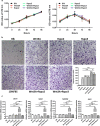R-spodin2 enhances canonical Wnt signaling to maintain the stemness of glioblastoma cells
- PMID: 30337838
- PMCID: PMC6180579
- DOI: 10.1186/s12935-018-0655-3
R-spodin2 enhances canonical Wnt signaling to maintain the stemness of glioblastoma cells
Abstract
Background: As newly identified Wnt enhancer, R-spondin gene family members have been linked to various cancers; however, their role in isocitrate dehydrogenase-wildtype subtype of human glioblastoma (GBM) cells remains unknown.
Methods: Human U87 and U251 cell lines were used to perform the experiments. GBM stem-like cells were enriched in stem cell growth media and induced to differentiate using retinoid acid or growth factor deprivation. Wnthigh and Wntlow subpopulations were isolated and evaluated by MTS, sphere formation, transwell migration and xenograft formation assays.
Results: R-spondin 2 but not R-spondin 3 potentiates Wnt/β-catenin signaling in GBM cell lines. While R-spondin 2 does not affect cell growth, it induces the expression of pluripotent stem cell markers in combination with Wnt3A. GBM stem-like cells are endowed with intrinsic high activity of β-catenin signaling, which can be further intensified by R-spondin 2. In addition, R-spondin2 promotes stem cell self-renewal and suppresses retinoid acid- or growth factor deprivation-induced differentiation, indicating R-spondin 2 maintains stem cell traits in GBM. On the other hand, we identify subpopulations of GBM cells that show distinctive responsiveness to Wnt/β-catenin signaling. Interestingly, Wnthigh and Wntlow cells display distinctive biologic properties. Moreover, Wnthigh cell-inoculated xenografts exhibit enhanced tumorigenicity and increased expression levels of R-spondin 2 compared to Wntlow cell-inoculated xenografts.
Conclusion: Our study reveals a novel regulatory mechanisms underlying the over-activation of β-catenin-mediated signaling in the pathogenesis of GBM.
Keywords: Cancer stem cells; Glioblastoma; R-spondin2; Stemness; Wnt.
Figures






References
-
- Gorlia T, van den Bent MJ, Hegi ME, Mirimanoff RO, Weller M, Cairncross JG, Eisenhauer E, Belanger K, Brandes AA, Allgeier A, et al. Nomograms for predicting survival of patients with newly diagnosed glioblastoma: prognostic factor analysis of EORTC and NCIC trial 26981-22981/CE.3. Lancet Oncol. 2008;9(1):29–38. doi: 10.1016/S1470-2045(07)70384-4. - DOI - PubMed
-
- Singh SK, Clarke ID, Terasaki M, Bonn VE, Hawkins C, Squire J, Dirks PB. Identification of a cancer stem cell in human brain tumors. Cancer Res. 2003;63(18):5821–5828. - PubMed
LinkOut - more resources
Full Text Sources
Research Materials

